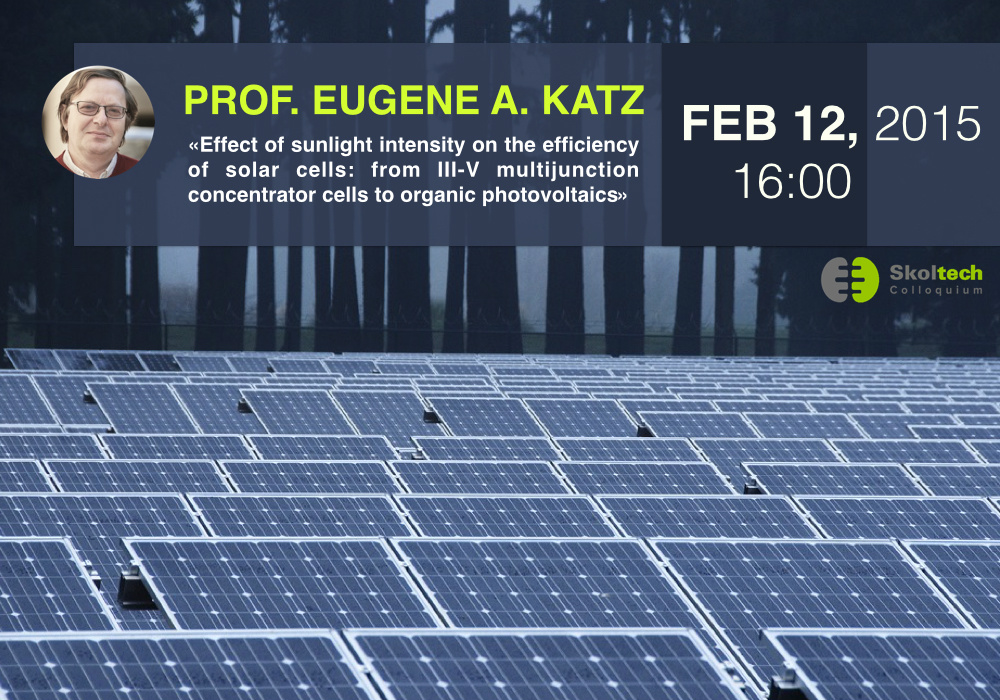Effect of sunlight intensity on the efficiency of solar cells:
From iii-v multijunction concentrator cells to organic photovoltaics
Eugene A. Katz
Dept. of Solar Energy and Environmental Physics, J. Blaustein Institutes for Desert Research, Ben-Gurion University of the Negev, Sede Boker Campus 84990 Israel
Most of photovoltaic (PV) approaches make the implicit assumption that the same area of expensive PV material that is needed to generate the electricity is also needed to collect the solar radiation. However, concentrator PV (CPV) changes this paradigm by separation the function of solar energy collection from that of solar energy conversion. The collection function is performed by large areas concentrating mirrors or lenses made that concentrate light onto a small area of efficient PV. The highest efficiency solar cells known are of III-V multi-junction cells (above 44 %). This approach pushes the CPV development towards accepting ever-higher concentration levels. In practice, concentrations of C = 1000 suns and higher are feasible (1 sun = 1mW/mm2).
Recently we have shown that a fiber-optic/mini-dish concentrator can be used as an indoor test facility for ultra-high-flux characterization of concentrator solar cells [1]. Both surprisingly high efficiencies of the multi-junction cells at C up to 10,000 suns [1] as well as novel physical phenomena (e.g., a hysteresis effect due to the tunnel diodes in multi-junction cells [2]) were discovered with this facility. In addition we have developed new test procedures for: (a) the cell efficiency with controlled variation of C (ranging from 1 to 10,000 suns) [3-4]; (b) effects of non-uniform irradiation of the cell as opposed to uniform irradiation [3-4]; (c) testing the integrity and uniformity of the cell as function of light spot location on the cell [3]; (d) testing of very small cells (with photoactive area of 1 mm2) [4].
In the second part of the lecture, I will report our recent findings on the effects of concentrated sunlight on key PV parameters and stability of organic photovoltaics (OPV), using the same experimental approach [5-7].
Finally, new research direction for ultra-high-efficient PV based on recycling of external photon emission is discussed [8].
References
- J.M. Gordon, E.A. Katz, D. Feuermann, M. Huleihil, Appl. Phys. Lett. 84, 3642 (2004).
- J.M. Gordon, E.A. Katz, W. Tassew, D. Feuermann, Appl. Phys. Lett. 86, 073508 (2005).
- E.A. Katz, J.M.Gordon, W.Tassew, D. Feuermann, J. Appl. Phys. 100, 044514 (2006).
- O. Korech, B.Hirsch, E.A. Katz, J.M. Gordon, Appl. Phys. Lett. 91, 064101 (2007).
- T. Tromholt,E. A. katz, B. Hirsch, A. Vossier and F. C. Krebs. Appl. Phys. Lett. 96, 073501 (2010).
- A. Manor, E. A. Katz, T. Tromholt, B. Hirsch and F. C. Krebs. Origin of size effect on efficiency of organic photovoltaics. J. Appl. Phys., 109, 074508 (2011).
- A. Manor, E. A. Katz, T. Tromholt and F. C. Krebs. Adv. Energy Mater.1, 836-843 (2011).
- A. Braun, E. A. Katz, D. Feuermann, B.M. Kayes, J.M. Gordon. Energy Env. Sci., 6, 1499 – 1503 (2013).
If you like to participate and for further information or questions, please Liliya Abaimova
We look forward to seeing you.

